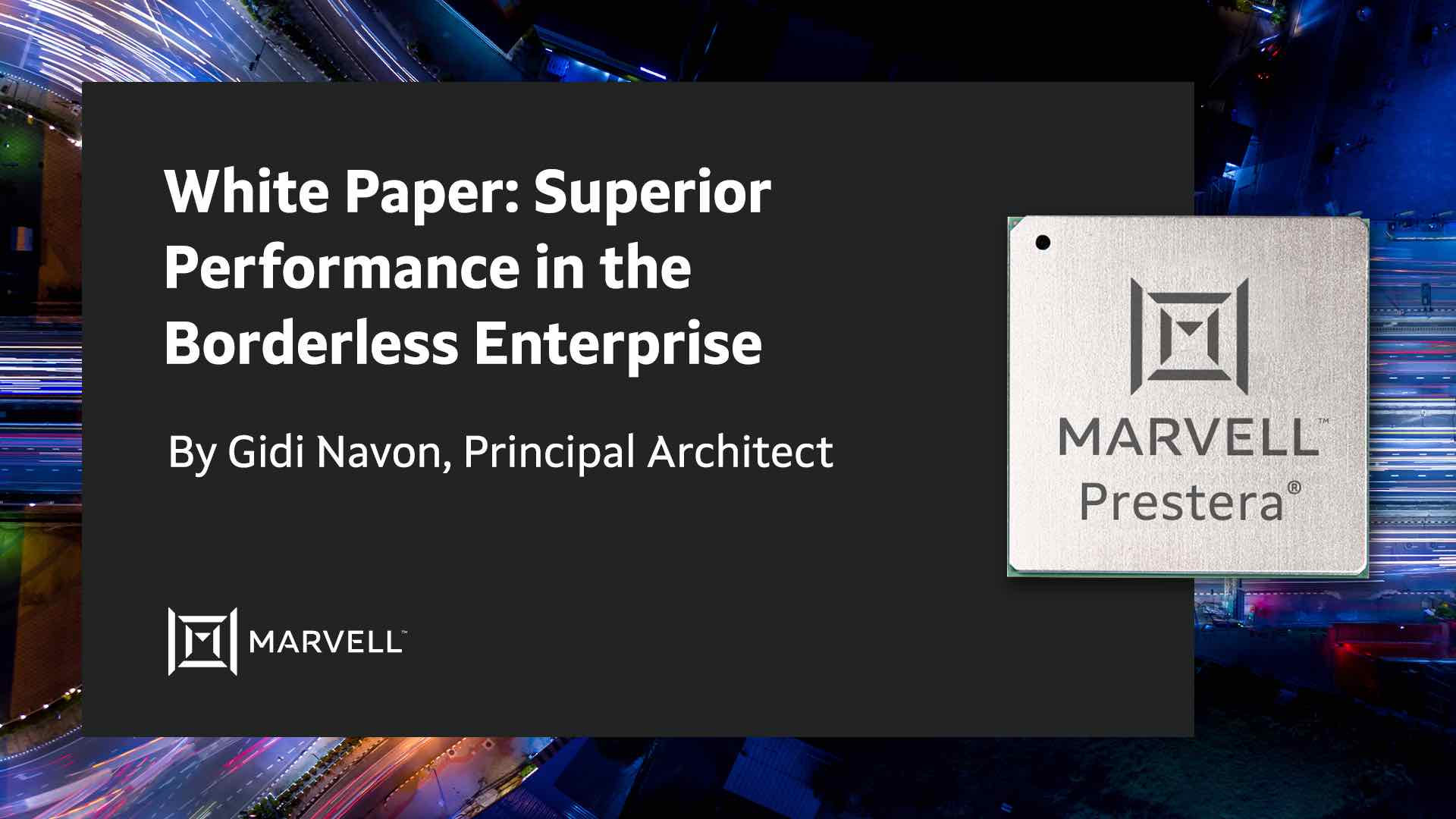Posts Tagged 'Ethernet network'
-
January 29, 2021
By Amir Bar-Niv, VP of Marketing, Automotive Business Unit, Marvell and John Bergen, Sr. Product Marketing Manager, Automotive Business Unit, Marvell
Some one hundred-and-sixty years later, as Marvell and its competitors race to reinvent the world’s transportation networks, universal design standards are more important than ever. Recently, Marvell’s 88Q5050 Ethernet Device Bridge became the first of its type in the automotive industry to receive Avnu certification, meeting exacting new technical standards that facilitate the exchange of information between diverse in-car networks, which enable today’s data-dependent vehicles to operate smoothly, safely and reliably.
-
November 01, 2020
无边界企业中的卓越性能 – 白皮书
By Gidi Navon, Senior Principal Architect, Marvell

-
March 02, 2018
Connecting Shared Storage – iSCSI or Fibre Channel
By Todd Owens, Field Marketing Director, Marvell
One of the questions we get quite often is which protocol is best for connecting servers to shared storage?
What customers need to do is look at the reality of what they need from a shared storage environment and make a decision based on cost, performance and manageability.
 Notes: 1. Optical transceiver needed at both adapter and switch ports for 10GbE networks. Thus cost/port is two times the transceiver cost 2. FC switch pricing includes full featured management software and licenses 3. FC Host Bus Adapters (HBAs) ship with transceivers, thus only one additional transceiver is needed for the switch port
Notes: 1. Optical transceiver needed at both adapter and switch ports for 10GbE networks. Thus cost/port is two times the transceiver cost 2. FC switch pricing includes full featured management software and licenses 3. FC Host Bus Adapters (HBAs) ship with transceivers, thus only one additional transceiver is needed for the switch port So if we do the math, the cost per port looks like this:
10GbE iSCSI with SFP+ Optics = $437+$2,734+$300 = $3,471
10GbE iSCSI with 3 meter Direct Attach Cable (DAC) =$437+$269+300 = $1,006
16GFC with SFP+ Optics = $773 + $405 + $1,400 = $2,578
Note, in my example, I chose 3 meter cable length, but even if you choose shorter or longer cables (HPE supports from 0.65 to 7 meter cable lengths), this is still the lowest cost connection option. Surprisingly, the cost of the 10GbE optics makes the iSCSI solution with optical connections the most expensive configuration.
It really comes down to distance and the number of connections required. The DAC cables can only span up to 7 meters or so. That means customers have only limited reach within or across racks. If customers have multiple racks or distance requirements of more than 7 meters, FC becomes the more attractive option, from a cost perspective.
- Latency is an order of magnitude lower for FC compared to iSCSI. Latency of Brocade Gen 5 (16Gb) FC switching (using cut-through switch architecture) is in the 700 nanoseconds range and for 10GbE it is in the range of 5 to 50 microseconds. The impact of latency gets compounded with iSCSI should the user implement 10GBASE-T connections in the iSCSI adapters. This adds another significant hit to the latency equation for iSCSI.
图 1: Cavium’s iSCSI Hardware Offload IOPS Performance

图 2:
Keep in mind, Ethernet network management hasn’t really changed much. Network administrators create virtual LANs (vLANs) to separate network traffic and reduce congestion. These network administrators have a variety of tools and processes that allow them to monitor network traffic, run diagnostics and make changes on the fly when congestion starts to impact application performance.
On the FC side, companies like Cavium and HPE have made significant improvements on the software side of things to simplify SAN deployment, orchestration and management. Technologies like fabric-assigned port worldwide name (FA-WWN) from Cavium and Brocade enable the SAN administrator to configure the SAN without having HBAs available and allow a failed server to be replaced without having to reconfigure the SAN fabric. Cavium and Brocade have also teamed up to improve the FC SAN diagnostics capability with Gen 5 (16Gb) Fibre Channel fabrics by implementing features such as Brocade ClearLink™ diagnostics, Fibre Chanel Ping (FC ping) and Fibre Channel traceroute (FC traceroute), link cable beacon (LCB) technology and more. HPE’s Smart SAN for HPE 3PAR provides the storage administrator the ability to zone the fabric and map the servers and LUNs to an HPE 3PAR StoreServ array from the HPE 3PAR StoreServ management console.
In many enterprise environments, there are typically dozens of network administrators. In those same environments, there may be less than a handful of “SAN” administrators. Yes, there are lots of LAN connected devices that need to be managed and monitored, but so few for SAN connected devices.
Well, it depends. If application performance is the biggest criteria, it’s hard to beat the combination of bandwidth, IOPS and latency of the 16GFC SAN. If compatibility and commonality with existing infrastructures is a critical requirement, 10GbE iSCSI is a good option (assuming the 10GbE infrastructure exists in the first place). If security is a key concern, FC is the best choice. When is the last time you heard of a FC network being hacked into?
-
January 11, 2018
以太网为车载网络带来根本性变革
By By Christopher Mash, Senior Director of Automotive Applications & Architecture, Marvell
目前汽车中采用的车载网络是基于几种不同数据网络协议的组合,其中一些已经使用了几十年。 第一种叫作控制器局域网 (CAN),主要负责动力总成和其他相关功能;第二种是本地互联网络 (LIN),主要用于对时间不敏感(如气候控制、环境照明、座椅调整等)的乘客和驾驶员舒适性用途;第三种是针对信息娱乐系统开发的面向媒体的系统传输 (MOST);第四种是用于防抱死制动 (ABS)、电子助力转向 (EPS) 和车辆稳定功能的 FlexRay™。
由于采用了不同的协议,需要使用网关在网络设施中传输数据, 由此产生的复杂性也增加了汽车厂商的制造成本, 每个网络所需的布线也增加了车辆的重量,进而会影响车辆的燃油经济性。 对于一辆汽车而言,布线的重量在整车中的占比仅次于发动机和底盘之后,名列第三;同样在成本方面,布线成本占总成本比例,也是第三位。 此外,这些网关也存在延迟问题,势必会影响到需要快速响应的安全关键型应用。
另一方面,汽车中的电子控制单元 (ECU) 数量在不断增加,目前豪华车型通常拥有 150 甚至更多个 ECU,甚至标准车型也拥有近 80~90 个 ECU。 与此同时,随着人们不断追逐更高级的汽车自动驾驶性能,数据密集型应用也在不断出现,以支持高级驾驶员辅助系统 (ADAS) 的实施。 所有这些都导致数据速率和整体带宽的显著提高,同时伴随高清摄像头和激光雷达技术的部署使用。
因此,对于目前车载网络的改进从整体技术来讲,需要的是一个根本性的改变。首先是所使用的拓扑结构,其次是它所依赖的底层技术。
目前,汽车内部的网络基础设施是基于域的架构。 There are different domains for each key function - one for body control, one for infotainment, one for telematics, one for powertrain, and so on. 一般这些域会使用不同类型相混合的网络协议(例如遵守 CAN、LIN 和其他相关协议)。
随着网络复杂性的不断提高,汽车工程师越来越清楚地认识到,这种不同的域使用不同协议的方法效率越来越低。 因此,在未来几年中,将需要从目前基于域的体系架构转向区域 (zonal) 架构。
区域架构实施方案可以使来自不同传统领域的数据,依据车辆中 ECU 的位置(区域)连接到同一个 ECU。 This arrangement will greatly reduce the wire harnessing required, thereby lowering weight and cost - which in turn will translate into better fuel efficiency. 以太网技术将成为中坚力量,推动车辆向基于区域的车载网络不断发展。
以太网技术除了能够支持高数据速率之外,还同时支持广受认可的 OSI 通信模型。 以太网作为一种稳定、历史悠久、且广为人知的技术,已经在数据通信和工业自动化领域得到广泛应用。 与其他车载网络协议不同,以太网明确定义了面向更高速度等级的发展路线图,而 CAN、LIN 等协议却已经是某些应用发展的瓶颈,而且也没有明确的升级路径来缓解问题。
展望未来,以太网技术将成为汽车所有数据传输的基础,通过提供一个共同的协议栈,减少不同协议之间对于网关的需求(以及硬件和相关的软件成本)。 结果将是整个车辆采用单一的同构网络,其中所有的协议和数据格式都是一致的。 这意味着,车载网络将可以扩展,从而实现一些要求更高速度(例如 10G)和更低延迟的功能,同时兼顾满足低速功能的需求。 Ethernet PHYs will be selected according to the particular application and bandwidth demands - whether it is a 1Gbps device for transporting imaging sensing data, or one for 10Mbps operation, as required for the new class of low data rate sensors that will be used in autonomous driving.
区域架构中的每个以太网交换机将能够为所有不同的域中的活动传送数据, 所有不同的数据域都将连接到本地交换机,再通过以太网骨干网聚合数据,从而更有效地使用已有的资源,以相同的核心协议,在需要时支持不同的速度。 这个同构网络将在车内提供“任何地点的任何数据”,还可以通过整合来自网络中不同域的数据来支持新的应用。
目前,在基于以太网的车载网络和车辆区域架构的发展方面,Marvell 处于佼佼者地位。2017年夏季,Marvell 推出了面向汽车市场并符合 AEC-Q100 标准的 88Q5050 安全千兆以太网交换机。 该设备不仅能够处理与标准以太网实施密切相关的 OSI Layers 1-2(物理层和数据层)功能,还具有位于 OSI Layers 3,4 及以上(网络层、传输层和更高层)的深度包检测 (DPI) 等其他功能。 这些与可信引导 (Trusted Boot) 功能相结合,可为汽车网络架构师提供对于确保网络安全至关重要的功能。

最近推文
- HashiCorp and Marvell: Teaming Up for Multi-Cloud Security Management
- Cryptomathic and Marvell: Enhancing Crypto Agility for the Cloud
- The Big, Hidden Problem with Encryption and How to Solve It
- Self-Destructing Encryption Keys and Static and Dynamic Entropy in One Chip
- Dual Use IP: Shortening Government Development Cycles from Two Years to Six Months


